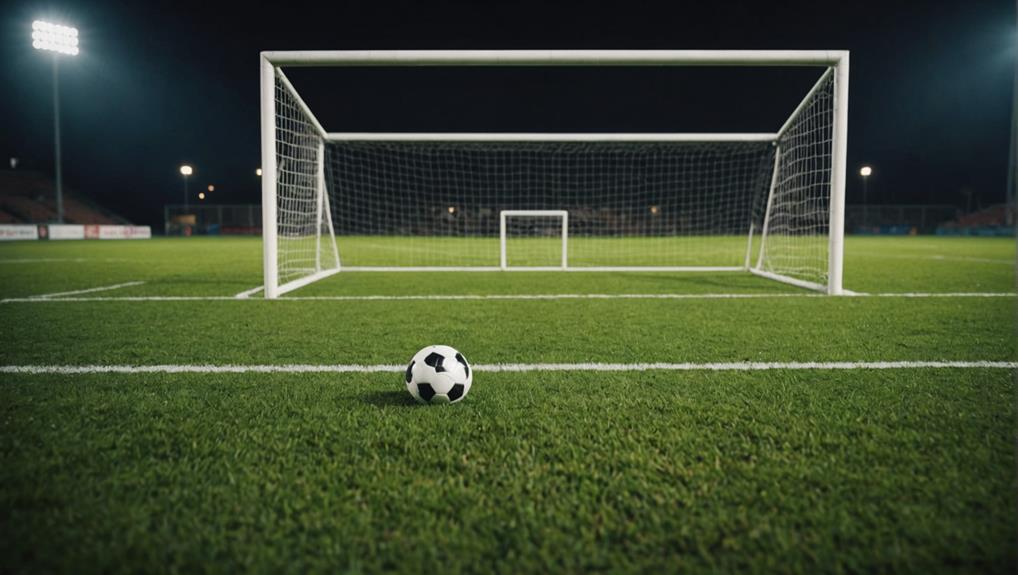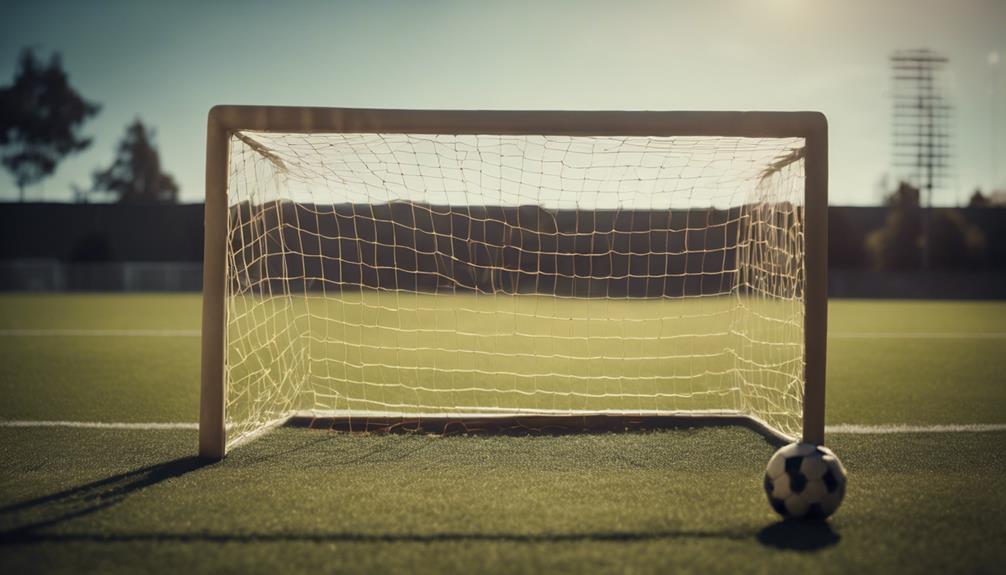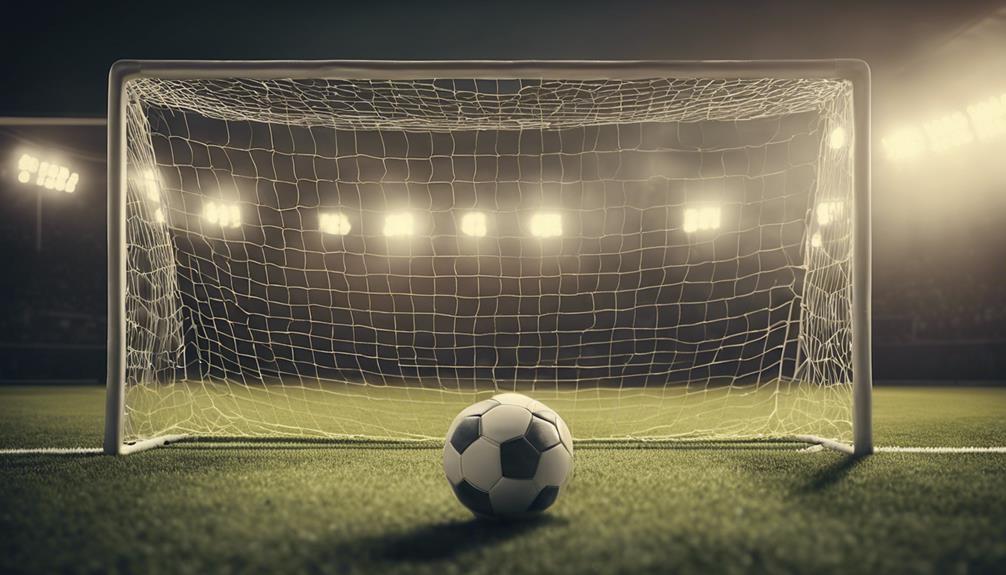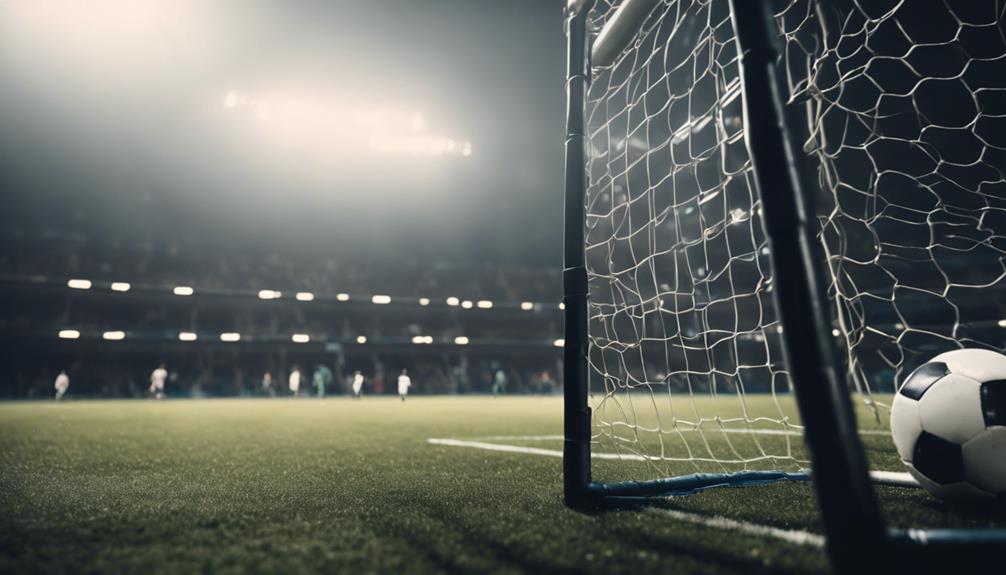
What Is the Soccer Goal Area? Explained
August 8, 2024Ever wondered about the soccer goal area? It extends 6 yards from each goal post and plays a pivotal role in the game. Goalkeepers have special privileges inside this space, allowing them to handle the ball freely. Goal kicks and free kicks can originate from here, influencing tactics and strategic plays. Fouls in the goal area result in free kicks for the attacking team outside the box. Understanding this area's rules and dimensions is essential for players and fans to grasp soccer regulations near the goal line. It's a key part of the game's dynamics, impacting both offense and defense strategies.
Goalie Box Rules
Explaining the rules of the goalie box is necessary for understanding the dynamics of soccer gameplay near the goal area. The goalie box, extending 6 yards from each side of the goal, is a critical area where goalkeepers have special privileges. Within this box, goalkeepers are allowed to handle the ball, providing a safe space for them to control the game. Both free kicks and goal kicks can originate from within the goalie box, offering teams strategic opportunities to restart play effectively.
Goal kicks, specifically, come into play when the ball crosses the end line without resulting in a goal. During a goal kick, the ball is placed inside the goalie box, and opposing players must remain outside the penalty area until the ball is in play.
Additionally, when free kicks are awarded to the attacking team within the goal area, they're taken near the 6-yard line just outside the goalie box. This positioning guarantees fair play and maintains the balance between offense and defense near the goal line.
Difference From Penalty Area
Distinguishing the goal area from the penalty area in soccer is essential for understanding key gameplay dynamics near the goal line. The goal area, also known as the six-yard box, is a smaller rectangular area located within the penalty area. It extends 6 yards from each goal post and 6 yards into the field, serving as an important area for goal kicks and defensive positioning.
Unlike the penalty area, the goal area is where goal kicks are taken and where goalkeepers can handle the ball with their hands. Free kicks awarded to the attacking team within the goal area are taken near the 6-yard line, just outside the goal box. Fouls committed by the defending team in the goal area result in free kicks for the attacking team, typically taken outside the goal box.
Understanding the distinction between the goal area and the penalty area is crucial for players and fans alike to grasp the different rules and strategies that come into play near the goal line.
Goalie Box Regulations

Let's talk about the key regulations within the goalie box.
This area is vital in soccer, with specific dimensions to adhere to during gameplay.
Understanding where free kicks are placed and the rules regarding goalkeeper handball inside this zone are essential for players and fans alike.
Goalie Box Dimensions
Standing 6 yards away from each side of the goal, the goalie box provides a designated area for goal kicks and goalkeeper ball-handling in soccer matches. This rectangular area is essential for goalkeepers to operate in, allowing them to use their hands legally within this zone.
The 6-yard line serves as a boundary for free kicks awarded to the attacking team inside the penalty area, just outside the goalie box. It's vital for fair play that opposing players stay outside the penalty area during goal kicks to guarantee proper restarts.
The goalie box dimensions are specifically designed to aid in the defense of the goal, facilitate goal kicks, and provide a clear boundary for goalkeeper actions. Goalkeepers rely on this area to restart play efficiently and protect the goal from incoming attacks.
Understanding the dimensions and regulations of the goalie box is fundamental for both goalkeepers and players to navigate the soccer field effectively.
Free Kick Location
To understand the regulations regarding free kick locations within the goalie box, one must take into account the strategic positioning and set-piece opportunities that arise from foul-induced situations in soccer matches.
When a free kick is awarded to the attacking team within the goal area, it's typically taken near the 6-yard line. This positioning allows for a direct attempt on goal or a well-placed pass to create scoring opportunities.
The goalie box, extending 6 yards from each side of the goal, serves as the designated area for goal kicks and free kicks, giving the attacking team a chance to capitalize on fouls near the goal. Keepers are permitted to handle the ball within the goalie box, adding a layer of defense to protect their goal.
Opposing players must stay outside the penalty area during goal kicks, emphasizing the significance of the goalie box in restart situations.
Foul-induced free kicks taken by the attacking team from outside the box require careful planning and execution to maximize scoring chances.
Goalkeeper Handball Rules
Exploring the regulations governing goalkeeper handball within the goalie box reveals key guidelines for their ball-handling privileges during gameplay. Goalkeepers are uniquely permitted to handle the ball with their hands within the penalty area, granting them a significant advantage in defending their goal. This privilege allows goalkeepers to make strategic saves and distribute the ball effectively to their teammates.
However, it's important to note that any handball offenses committed by the goalkeeper outside the penalty area can result in disciplinary action, such as receiving cards.
During goal kicks, goalkeepers can take the kick from within the goalie box, which extends 6 yards from the goal line. Conversely, free kicks awarded to the attacking team in the penalty area are taken near the 6-yard line outside the goalie box.
Additionally, fouls committed by the defending team within the penalty area lead to penalty kicks, with the penalty spot located 12 yards from the goal line. Understanding these regulations is vital for goalkeepers to navigate their responsibilities effectively within the goalkeeper box during matches.
Penalty Area Rules
Now, let's talk about the rules within the penalty area.
You'll learn about the regulations for penalty kicks, the permissions for goalkeepers to handle the ball, and the restrictions on defensive free kicks.
Penalty Kick Regulations
The regulations for penalty kicks within the soccer goal area dictate specific rules for player positioning and conduct during these pivotal moments in a match.
When it comes to penalty kick regulations:
- Penalty Kick Award: Penalty kicks are awarded when the defending team commits a foul inside the penalty area, resulting in a direct free shot from the penalty spot.
- Player Restrictions: Only the designated kicker and the goalkeeper are allowed inside the penalty area during a penalty kick. Defending team players must stay outside the penalty area until the kick is taken.
- Regulation of Positioning: The penalty spot, located 12 yards from the goal line, is where the penalty kicks are taken from. The penalty arc, positioned 10 yards from the penalty spot, helps regulate the positioning of players during penalty kicks, ensuring fair play and adherence to the rules.
Goalkeeper Handball Permissions
Goalkeepers are allowed to use their hands within the penalty area during a soccer match. This permission is exclusive to the goalkeeper and only applies within the 18-yard box surrounding the goal.
When the defending team commits a foul within the penalty area, the result can be a penalty kick awarded to the attacking team. During a penalty kick, only the designated kicker and the goalkeeper are allowed inside the penalty area, while all other players must remain outside. It's essential for opponents to respect this rule to guarantee a fair opportunity for the penalty kick taker.
Additionally, when the goalkeeper handles the ball outside the penalty area, it results in a direct free kick for the opposing team. Understanding and adhering to these handball permissions within the penalty area are fundamental for both the defending and attacking sides in a soccer match.
Defensive Free Kick Restrictions
During defensive free kicks in soccer matches, strict rules govern the behavior of defending players inside the penalty area. When the opposing team is setting up for a free kick near the penalty area, certain restrictions come into play to ensure fair play and prevent any advantage for the defending team.
Here are some key points to remember:
- Stay Outside the Penalty Area: Defending players must respect the penalty area boundaries and remain outside the box until the free kick is taken. This rule prevents them from obstructing the attacking team's opportunity to score.
- Avoid Encroachment: It's essential for defending players not to encroach into the penalty area before the free kick is executed. This restriction aims to maintain the integrity of the set-piece situation and avoid any interference with the play.
- Restricted Zone: The penalty area acts as a restricted zone during defensive free kicks, creating a clear boundary that defending players must adhere to. Any violation of this rule can result in consequences such as the free kick being retaken or other penalties being imposed.
About Penalty Arc

Positioned precisely ten yards away from the penalty spot, the penalty arc serves as a boundary during penalty kicks in soccer matches. This arc, with its distinct curved line, acts as a designated area to secure fair play during penalty kicks. It plays a vital role in maintaining order and separating the penalty kick-taker from other players on the field. Both teams must adhere to the rules of the penalty arc, staying outside of it during penalty kicks to prevent any unfair advantages.
Violating the boundaries of the penalty arc can result in the penalty kick being retaken, highlighting the importance of this demarcated space. By enforcing the 10-yard distance from the penalty spot, the penalty arc helps regulate the proper procedures and conduct during penalty kicks, contributing to the integrity and sportsmanship of the game.
Next time you watch a soccer match, observe how the penalty arc influences the dynamics of penalty kicks and upholds the principles of fair play in the sport.
Goalie Box Vs. Penalty Area
Comparing the goalie box and the penalty area reveals distinct differences in their dimensions and roles on the soccer field. Here's what sets them apart:
1. Goalie Box:
The goalie box is a 6-yard area from each side of the goal. Goalkeepers can handle the ball with their hands in this region during play. Free kicks awarded to the attacking team within the goal area are taken near the 6-yard line outside the goalie box.
2. Penalty Area:
The penalty area is an 18-yard box surrounding the goal. It's a pivotal area where fouls can result in penalty kicks. Goalkeepers can also use their hands in the penalty area during gameplay. The penalty area is significant for defensive strategies and is where penalty kicks are taken from.
Understanding the distinctions between the goalie box and the penalty area is vital for players and fans alike to grasp the intricacies of the game.
Purpose of Six Yard Box

The six-yard box in soccer serves as a designated area for goal kicks and strategic defensive plays. This area, also known as the goal area, plays an important role in regulating the game. It's the spot from which goal kicks are taken, providing a clear starting point for teams to restart play after the ball goes out of bounds near the goal.
Additionally, the six-yard box limits the proximity for indirect free kicks, ensuring that defenders aren't unfairly disadvantaged. Furthermore, the defending team can use the six-yard box to their advantage when taking free kicks for fouls committed by the attacking team within this area. This strategic positioning allows defenders to set up their defensive plays effectively.
The six-yard box also dictates the restart point for dropped balls within the penalty area, contributing to the overall structure and fairness of the game. Its significance extends beyond just defining the goalkeeper's territory, influencing various aspects of play and decision-making on the field.
Goal Area Guidelines
Understanding the strategic importance of the goal area in soccer enhances gameplay tactics and defensive strategies. The goal area, extending 6 yards from each goal post, plays a pivotal role in different aspects of the game:
- Goal Kicks: These kicks are taken from within the goal area to restart play when the ball goes out of bounds over the goal line. They offer teams a chance to regroup and shift from defense to offense effectively.
- Free Kicks: When the attacking team is awarded a free kick within the goal area, it's taken near the 6-yard line. This positioning presents a prime opportunity for teams to score or create dangerous goal-scoring chances.
- Goalkeepers: Within the goal area, goalkeepers are permitted to use their hands during gameplay. This privilege allows them to make crucial saves and organize their defense efficiently to prevent goals.
The goal area serves as a designated zone for specific restarts and provides goalkeepers with a tactical advantage to protect their goal effectively.
Conclusion
As you can see, the soccer goal area is an essential part of the game. It serves as the goalkeeper's domain and plays a pivotal role in determining the outcome of matches.
So next time you watch a game, keep an eye on the goal area and see how players maneuver around it to score or defend. It's where the magic happens, where dreams are made or shattered in the blink of an eye.
So pay close attention and witness the drama unfold.


